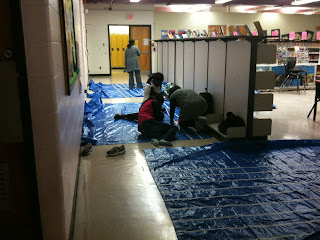In Artemis' Full Day kindergarten class, her students were given the opportunity to problem solve - and connect that problem to a larger school wide issue. The school had adopted 6 families for the holiday season. Students and their families were asked to donate clothing, food and personal items to help support the cause.
For the minds on part of her three part lesson, Artemis read the students the book "The Jacket I Wear In The Snow" to get the students thinking about items you need for winter. The problem (action) that Artemis gave her students was this: We've been collecting clothing for families in need. We can put ten things in each box we give them. We are going to make boxes of hats and mittens. What combinations of hats and mittens could you put in a box?
The students did a wonderful job of creating various boxes with different combinations of hats and mittens. As they worked, Artemis was able to record not only the combinations that they made (e.g., 4 hats and 6 mittens) how they counted (was it one-on-one, did they count by 2s?) and probe them to explain their thinking (How do you know you are done? Why do you think you have put ten things in the box?).
To finish off the lesson, (consolidate) the students came back to the carpet and recorded their boxes on a chart. Artemis then continued to ask questions about the boxes that the students made. (Who had more mittens in their box? Alyssa or Shiva? How do you know?)
Wednesday, December 22, 2010
Bansho For Where To Go Next
As part of Wexford's Math Pathway, the Junior and Intermediate divisions decided to focus on strategies. To help them gain a better understanding of what strategies their students had for Patterning and Algebra, they had them do a pre-assessment task prior to their PLC. The pre-assessment was done "cold turkey" with no pre-teaching prior to giving it to them. This allowed the teachers to get a real understanding of what strategies their students already had in place.
Where things changed was when they began to look at all of the strategies that their students were using from Grades 4-8. Each teacher looked through their pile of work, and pulled out the different strategies that their students were using. We then assembled those strategies into a Bansho format.
By doing this, it allowed us to look at the strategies that students already had - But also allowed us the opportunity to look at strategies that we may have not been familiar with and see how to use them. As well, it allowed us to make note of strategies that we want to model for our students, and also allowed us the chance to see how to help move out students along in their development of strategies.
Where things changed was when they began to look at all of the strategies that their students were using from Grades 4-8. Each teacher looked through their pile of work, and pulled out the different strategies that their students were using. We then assembled those strategies into a Bansho format.
By doing this, it allowed us to look at the strategies that students already had - But also allowed us the opportunity to look at strategies that we may have not been familiar with and see how to use them. As well, it allowed us to make note of strategies that we want to model for our students, and also allowed us the chance to see how to help move out students along in their development of strategies.
Friday, December 3, 2010
40 Teachers and Tarps?!?!
Recently 40 teachers from South East One got together to create their very own learning carpets. The Learning Carpet is a great tool to use in your classroom as it can cover everything from teaching numbers to graphing. It's also very hands on and a great way for kinestetic learners to complete an activity. Our "carpets" were made from masking tape and tarps. It was a great night had by all. For more information about The Learning Carpet, check out Wendy Hill's website (she's the creator of the carpet) http://www.thelearningcarpet.ca/
Subscribe to:
Comments (Atom)









